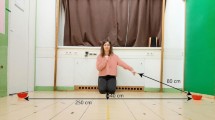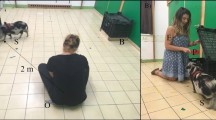Abstract
Since the observations of O. Pfungst the use of human-provided cues by animals has been well-known in the behavioural sciences (“Clever Hans effect”). It has recently been shown that rhesus monkeys (Macaca mulatta) are unable to use the direction of gazing by the experimenter as a cue for finding food, although after some training they learned to respond to pointing by hand. Direction of gaze is used by chimpanzees, however. Dogs (Canis familiaris) are believed to be sensitive to human gestural communication but their ability has never been formally tested. In three experiments we examined whether dogs can respond to cues given by humans. We found that dogs are able to utilize pointing, bowing, nodding, head-turning and glancing gestures of humans as cues for finding hidden food. Dogs were also able to generalize from one person (owner) to another familiar person (experimenter) in using the same gestures as cues. Baseline trials were run to test the possibility that odour cues alone could be responsible for the dogs’ performance. During training individual performance showed limited variability, probably because some dogs already “knew” some of the cues from their earlier experiences with humans. We suggest that the phenomenon of dogs responding to cues given by humans is better analysed as a case of interspecific communication than in terms of discrimination learning.
Similar content being viewed by others
References
Anderson JR, Sallaberry P, Barbier H (1995) Use of experimenter-given cues during object choice tasks by capuchin monkeys. Anim Behav 49: 201–208
Anderson JR, Montant M, Schmitt D (1996) Rhesus monkeys fail to use gaze direction as an experimenter-given cue in an object-choice task. Behav Proc 37: 47–55
Andrew RJ (1962) The origin and evolution of the calls and facial expressions of the primates. Behaviour 20: 1–109
Barker SB, Barker RT (1988) The human-canine bond: closer than family ties? J Mental Health Counsel 10: 46–56
Blaschke M, Ettlinger G (1987) Pointing as an act of social communication by monkeys}. Anim Behav 35: 1520–1523
Bolwig N (1964) Facial expression in primates with remarks on a parallel development in a certain carnivores. Behaviour 22: 167–192
Butterworth G Jarrett N 1991 What minds have in common is spaces patial mechanisms serving joint visual attention in infancy. Br J Dev Psychol 955-7
Candland DK (1993) Feral children and clever animals. Oxford University Press, New York
Cox RP (1993) The human/animal bond as a correlate of family functioning. Clin Nursing Res 2: 224–231
Emery NJ, Lorincz EN, Perrett DI, Oram MW, Baker CI (1997) Gaze following and joint attention in rhesus monkeys (Macaca mulatta). J Comp Psychol 111: 286–293
Fox MW (1970) A comparative study of development of facial expressions in canids, wolf, coyote and foxes. Behaviour 36: 49–73
Frank H (1980) Evolution of canine information processing under conditions of natural and artificial selection. Z Tierpsychol 59: 389–399
Freedman DG, King JA, Elliot O (1961) Critical periods in the social development of dogs. Science 133: 1016–1017
Ginsburg BE (1976) Evolution of communication patterns in animals.: In: Hahn ME, Simmel EC (eds) Communicative behaviour and evolution. Academic Press, New York, pp 59–79
Gomez JC (1996) Ostensive behaviour in great apes: the role of eye contact. In: Russon AE, Parker ST, Bard K (eds) Reaching into thought. Cambridge University Press, Cambridge, pp 131–151
Harlow HF (1951) Primate learning. In: Stone TP (ed) Comparative psychology. Prentice-Hall, New York, pp 183–238
Hooff JARAM van (1962) Facial expressions in higher primates. Symp Zool Soc Lond 8: 97–125
Itakura S (1996) An exploratory study of gaze-monitoring in nonhuman primates. Jpn Psychol Res 38: 174–180
Itakura S, Anderson JR (1996) Learning to use experimenter-given cues during an object-choice task by a capuchin monkey. Curr Psychol Cogn 15: 103–112
Itakura S, Tanaka M (1998) Use of experimenter-given cues during object choice tasks by chimpanzee (Pan troglodytes), and orangutan (Pongo pygmaeus) and human infants (Homo sapiens). J Comp Psychol 112: 119–126
Jenkins WO (1943) A spatial factor in chimpanzee learning. J Comp Psychol 35: 81–84
Kretchmer KR, Fox MW (1975) Effects of domestication on animal behaviour. Vet Rec 96: 102–108
Leung EHL, Rheingold HL (1981) Development of pointing as a social gesture. Dev Psychol 17: 215–220
Maestripieri D (1996) Gestural communication and its cognitive implication in pigtail macaques (Macaca nemestrina). Behaviour 133: 997–1022
McConell PB, Baylis JR (1985) Interspecific communication in cooperative herding: acoustic and visual signals from shepherds and herding dogs. Z Tierpsychol 67: 302–328
Mech LD (1970) The wolf: the ecology and behaviour of an endangered species. Natural History, New York
Menzel EW (1973) Leadership and communication in young chimpanzees. In: Menzel EW (ed) Precultural primate behaviour. Karger, Basel, pp 192–125
Messent P, Serpell J (1981) An historical and biological view of the pet owner bond. In: Fogle B (ed) Interrelations between people and pets. Thomas, Springfield, pp 5–22
Miller RE, Murphy JV (1964) Influence of the spatial relationships between the cue, reward, and response in discrimination learning. J Exp Psychol 67: 120–123
Murphy JV, Miller RE (1955) The effect of spatial contiguity of cue and reward in the object-quality learning of rhesus monkeys. J Comp Physiol Psychol 48: 221–224
Niebuhr BR, Levinson M, Nobbe DE, Tiller JE (1980) Treatment of an incompletely socialized dog. In: Hart BL (ed) Canine behaviour. Veterinary Practice, Santa Barbara, pp 83–85
Pepperberg IM, McLaughlin MA (1996) Effect of avian-human joint attention on allospecific vocal learning by grey parrots (Psittacus erithacus). J Comp Psychol 110: 286–297
Pfungst O (1911) Clever Hans. The horse of Mr. von Osten. Henry Holt, New York
Povinelli DJ, Eddy TJ (1996) Chimpanzees: joint visual attention. Psychol Sci 7: 129–135
Povinelli, DJ, Eddy TJ (in press) Factors influencing young chimpanzees’ (Pan troglodytes) recognition of attention. J Comp Psychol
Povinelli, DJ, Eddy TJ (1997) Specificity of gaze-following in young chimpanzees. Br J Dev Psychol 15: 213–222
Povinelli DJ, Nelson KE, Boysen ST (1990) Inferences about guessing and knowing by chimpanzees (Pan troglodytes). J Comp Psychol 104: 203–210
Povinelli DJ, Parks KA, Novak MA (1991) Do rhesus monkeys (Macaca mulatta) attribute knowledge and ignorance to others? J Comp Psychol 105: 318–325
Redican WK (1975) Facial expressions in nonhuman primates. In: Rosenblum LA (ed) Primate behaviour: developments in field and laboratory research, vol 4. Academic Press, New York, pp 103–194
Sackett GP, Porter M, Holmes H (1965) Choice behaviour in rhesus monkeys: effect of stimulation during the first month of life. Science 147: 304–306
Schenkel R (1947) Ausdrucksstudien an Wülfen. Behaviour 1: 81–129
Scott JP (1992) The phenomenon of attachment in human-nonhuman relationships. In: Davis H, Balfour D (eds) The inevitable bond. Cambridge University Press, Cambridge, pp 72–92
Scott JP, Fuller JL (1965) Genetics and the social behaviour of the dog. University of Chicago Press, Chicago
Serpell J (1995) The domestic dog. Cambridge University Press, Cambridge
Sigg H, Stolba A (1981) Home range and daily march in a hamadryas baboon troop. Folia Primatol 36: 40–75
Topál J, Miklósi A, Dóka A, Csányi V (1998) Attachment behaviour in dogs: a new application of the Ainsworth's strange situation test. J Comp Psychol 112: 218–229
Vilá C, Savolainen P, Maldonado JE, Amorim IR, Rice JE, Homeycutt RL, Crandall KA, Lundeberg J, Wayne RK (1997) Multiple and ancient origins of the domestic dog. Science 276: 1687–1689
Weigel RM (1979) The facial expressions of the brown capuchin monkey (Cebus apella). Behaviour 68: 250–276
Author information
Authors and Affiliations
Rights and permissions
About this article
Cite this article
Miklösi, Á., Polgárdi, R., Topál, J. et al. Use of experimenter-given cues in dogs. Anim Cogn 1, 113–121 (1998). https://doi.org/10.1007/s100710050016
Received:
Revised:
Published:
Issue Date:
DOI: https://doi.org/10.1007/s100710050016




